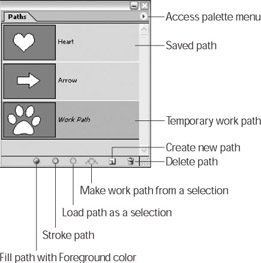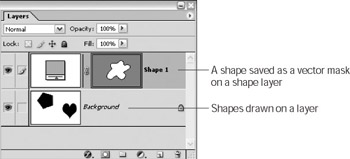Chapter 16: Using Paths and Shapes
Overview
In This Chapter
-
Learning about the shape tools
-
Finding out about shape layers and paths
-
Creating shapes
-
Working with shape layers
-
Rasterizing a shape layer
-
Discovering the anatomy of a path
-
Drawing paths
-
Reshaping and transforming paths
-
Filling and stroking paths
-
Creating vector masks
Besides being an extraordinary painting program, Photoshop also uses vector graphics to create paths and shapes such as rectangles, circles, hearts, and stars.
As you found out at the beginning of Chapter 5, bitmap images are made up of tiny pixels that are arranged and colored to form a pattern. These bitmap images are the ones you usually create in a bitmap-based program such as Photoshop.
Vector graphics create shapes and objects, such as squares and stars, using mathematical formulas. Photoshop stepped over the bitmap-based program line in Version 6 when it included the ability to add vector graphics to Photoshop images.
Photoshop’s shape tools and pen tools are used to create exact vector shapes. These vector shapes are called paths. Paths are classified in two ways:
-
Work paths: Temporary paths that define the outline of a shape. They appear in the Paths palette, as shown in Figure 16-1.

Figure 16-1: Work paths are temporary outlines that appear in the Paths palette. -
Shape layers: Paths that are created when a shape is drawn and automatically filled with the current Foreground color. The shape appears in the Layers palette as an outline that is stored in a vector mask, which also shows up in the Paths palette.
| Remember | A vector mask works just like a layer mask, hiding some areas of the layer and revealing other areas. The vector mask is linked to a layer. This combination vector mask and layer makes up the shape layer. |
You also can use the shape tools to create shapes, such as ellipses and triangles, directly on a layer. This type of shape is pixel based and they cannot be modified — transformed, reshaped, or used as selections — like the shapes saved in vector masks. Both are shown in Figure 16-2.

Figure 16-2: Shapes can be drawn either directly on a layer or as a shape layer. The shape layer saves the shape’s outline in a vector mask that is linked to the layer.
EAN: 2147483647
Pages: 221